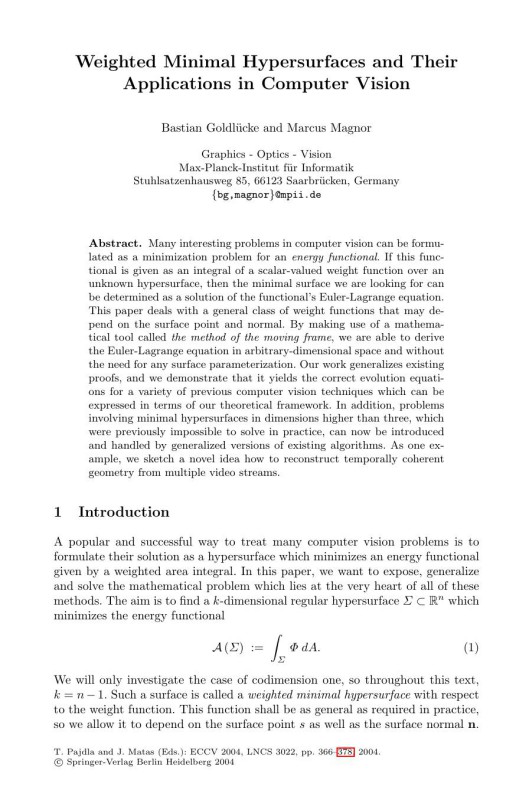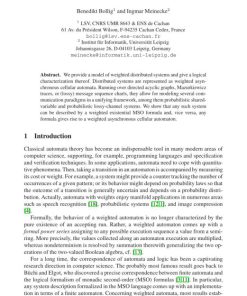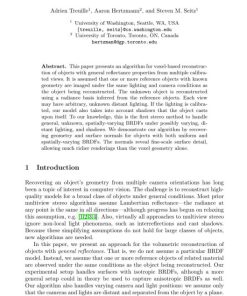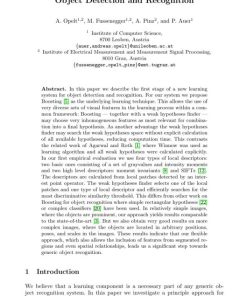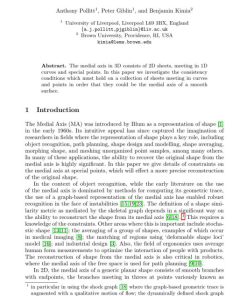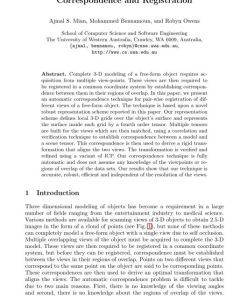Weighted Minimal Hypersurfaces and Their Applications in Computer Vision 1st edition by Bastian Goldlucke, Marcus Magnor ISBN 3540219835 9783540219835
$50.00 Original price was: $50.00.$25.00Current price is: $25.00.
Authors:Bastian Goldlücke; Marcus Magnor , Tags:Computer Vision – ECCV 2004 , Author sort:Goldlücke, Bastian & Magnor, Marcus , Languages:Languages:eng , Published:Published:Mar 2004
Weighted Minimal Hypersurfaces and Their Applications in Computer Vision 1st edition by Bastian Goldlücke, Marcus Magnor – Ebook PDF Instant Download/Delivery. 3540219835, 978-3540219835
Full download Weighted Minimal Hypersurfaces and Their Applications in Computer Vision 1st Edition after payment

Product details:
ISBN 10: 3540219835
ISBN 13: 978-3540219835
Author: Bastian Goldlücke, Marcus Magnor
Many interesting problems in computer vision can be formulated as a minimization problem for an energy functional. If this functional is given as an integral of a scalar-valued weight function over an unknown hypersurface, then the minimal surface we are looking for can be determined as a solution of the functional’s Euler-Lagrange equation. This paper deals with a general class of weight functions that may depend on the surface point and normal. By making use of a mathematical tool called the method of the moving frame, we are able to derive the Euler-Lagrange equation in arbitrary-dimensional space and without the need for any surface parameterization. Our work generalizes existing proofs, and we demonstrate that it yields the correct evolution equations for a variety of previous computer vision techniques which can be expressed in terms of our theoretical framework. In addition, problems involving minimal hypersurfaces in dimensions higher than three, which were previously impossible to solve in practice, can now be introduced and handled by generalized versions of existing algorithms. As one example, we sketch a novel idea how to reconstruct temporally coherent geometry from multiple video streams.
Weighted Minimal Hypersurfaces and Their Applications in Computer Vision 1st Table of contents:
-
Introduction
- 1.1 Background and Motivation
- 1.2 Minimal Surfaces in Computer Vision
- 1.3 Introduction to Weighted Minimal Hypersurfaces
- 1.4 Key Applications in Computer Vision
- 1.5 Objectives and Contributions of the Paper
- 1.6 Structure of the Paper
-
Related Work
- 2.1 Minimal Surfaces and Their Role in Geometry and Vision
- 2.2 Weighted Geometries and Their Relevance
- 2.3 Applications of Minimal Surfaces in Computer Vision
- 2.4 Challenges in Using Minimal Surfaces for Vision Tasks
- 2.5 Recent Advances and Open Problems
-
Mathematical Foundations
- 3.1 Differential Geometry and Minimal Surfaces
- 3.2 Definition of Minimal Hypersurfaces
- 3.3 Weighted Minimal Hypersurfaces: Definition and Properties
- 3.4 Variational Formulations for Minimal Surfaces
- 3.5 Relationship Between Weighted Minimal Hypersurfaces and Energy Minimization
-
Construction of Weighted Minimal Hypersurfaces
- 4.1 The Role of Weight Functions in Geometry
- 4.2 Mathematical Methods for Constructing Weighted Minimal Hypersurfaces
- 4.3 Numerical Approximations and Algorithms for Surface Construction
- 4.4 Solving Partial Differential Equations for Surface Evolution
- 4.5 Stability and Convergence of Weighted Minimal Hypersurfaces
-
Applications in Computer Vision
- 5.1 Surface Reconstruction from 3D Data
- 5.2 Image Segmentation Using Weighted Minimal Hypersurfaces
- 5.3 Object Recognition and Feature Extraction via Minimal Surfaces
- 5.4 Shape Analysis and Matching in Computer Vision
- 5.5 Texture Mapping and Smoothing in Vision Tasks
-
Algorithm Design and Implementation
- 6.1 Overview of the Algorithm for Constructing Weighted Minimal Hypersurfaces
- 6.2 Integration with Computer Vision Pipelines
- 6.3 Practical Considerations in Real-Time Applications
- 6.4 Computational Efficiency and Parallelization Techniques
- 6.5 Handling Large-Scale Datasets and Complex Geometries
-
Experimental Setup and Evaluation
- 7.1 Datasets for Testing Weighted Minimal Hypersurfaces
- 7.2 Evaluation Metrics for Surface Accuracy and Segmentation Quality
- 7.3 Comparative Methods in Object Recognition and Surface Reconstruction
- 7.4 Experimental Protocols and Cross-Validation
- 7.5 Results and Performance in Real-World Computer Vision Tasks
-
Results and Discussion
- 8.1 Visual Examples of Weighted Minimal Hypersurface Applications
- 8.2 Quantitative Results: Surface Reconstruction and Segmentation Accuracy
- 8.3 Performance of Weighted Minimal Hypersurfaces in Object Recognition
- 8.4 Analysis of Computation Time and Scalability
- 8.5 Discussion of the Advantages and Limitations of the Approach
-
Applications and Future Directions
- 9.1 Applications in Robotics and Autonomous Systems
- 9.2 Integration with Machine Learning and Deep Learning for Vision Tasks
- 9.3 Future Developments in Geometric and Topological Computer Vision
- 9.4 Scaling to Complex and Noisy Real-World Data
- 9.5 Potential Applications in Medical Imaging and 3D Reconstruction
-
Challenges and Open Problems
- 10.1 Handling Non-Smooth and Discontinuous Surfaces
- 10.2 Dealing with Large-Scale and High-Resolution Data
- 10.3 Generalization to Multiple Viewpoints and Occlusions
- 10.4 Improving the Efficiency of Surface Construction Algorithms
- 10.5 Open Theoretical Questions in Weighted Minimal Hypersurfaces
-
Conclusion
- 11.1 Summary of Key Contributions and Findings
- 11.2 Impact of Weighted Minimal Hypersurfaces in Computer Vision
- 11.3 Practical Implications for Object Recognition, Segmentation, and Reconstruction
- 11.4 Limitations and Future Work
People also search for Weighted Minimal Hypersurfaces and Their Applications in Computer Vision 1st :
hypersurface weighted projective space
minimal surface hyperbolic space
surface weighted mean d 3 2
minimal hypersurfaces of spheres with constant scalar curvature
hyperflex wetsuit size chart

